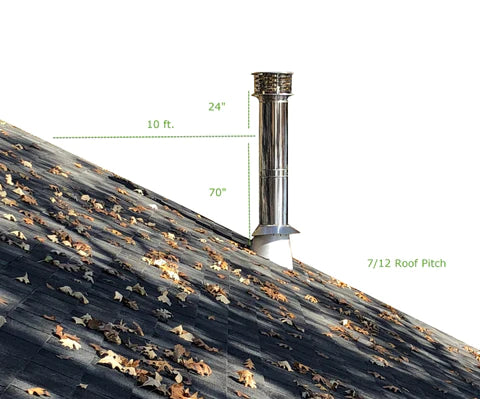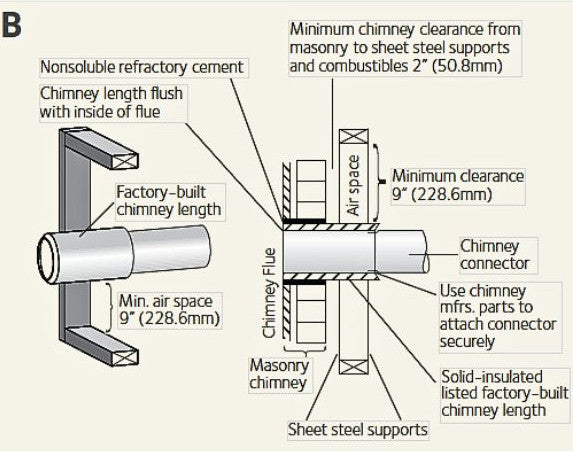Chimney Pipe Height Requirements
July 19, 2023

Installing a Class A chimney system is an easy way to vent a wood stove without having the expense of constructing a full masonry chimney. However, planning the installation is very important. Don't worry though, we're here to help you through it! Many factors must be taken into consideration to have a safe and proper U.L. approved installation. One of the most important aspects of the planning process is installing the proper amount of chimney pipe above the roof.
3-2-10 Rule Explained
If you've been researching Class A chimney pipes, you've probably heard of the 3-2-10 foot rule numerous times. This rule refers to the proper height of the chimney pipe above the roof. Explained, the chimney pipe must be a minimum of three feet above the roof but also two feet taller than anything within ten feet.
- Minimum three feet above the high side of the roof
- At least two feet taller than anything within ten feet
The portion of the rule stating the pipe needs to be 2 feet above anything within 10 feet is where most people get confused. Most people think of that in terms of trees, satellites, or other parts of the home, which are all accurate, but neglect to consider the roof itself. The higher the roof pitch is, the closer the roof will be to the pipe where it penetrates the roof. This doesn't necessarily mean the pipe must be above the tallest part of the roof, which is known as the ridge. But, the pipe will require a 10' horizontal clearance from the roof.
Easy Calculation for Chimney Pipe Height
Knowing the pitch of the roof is extremely helpful in determining the height the chimney pipe must be above the roof. Roof pitch explained simply is rise over run. The 'rise' is the vertical rise of the roof over the 'run' which is the horizontal distance. In the construction world, the run is defined as 12 which is 12" of horizontal run. So, the roof pitch is determined by how many inches the roof rises to the peak over 12" in horizontal length.
Here is a helpful article explaining how to measure roof pitch.
Next, we need to know if the penetration in the roof will be within ten feet horizontal distance of the ridge. If you are further than 10' horizontal distance from the ridge, we will use a multiplier of 10 feet since this requirement is covered. Anything closer than 10', you will use that measurement as the multiplier.
Once we know our roof pitch and our distance from the ridge, it is now very easy to determine the chimney height by doing a little math.
Example #1:
 For example, let's say our roof pitch is 7/12 (7" of vertical rise over 12" of horizontal run) and the roof penetration is further than 10 feet horizontal away from the ridge of the roof. We take the roof pitch rise of 7" and multiply that by 10 which equals 70". This means if we measure up 70" at the roof penetration, we will have a horizontal clearance from the roof by 10'. Now that we have a clearance of 10' we must be 2' (or 24 inches) higher than that point. Now we add 24" to the 70" which gives us a chimney height above the roof of 94". The chimney in this example must extend 94" above the roof, measured from "uphill" side of the chimney.
For example, let's say our roof pitch is 7/12 (7" of vertical rise over 12" of horizontal run) and the roof penetration is further than 10 feet horizontal away from the ridge of the roof. We take the roof pitch rise of 7" and multiply that by 10 which equals 70". This means if we measure up 70" at the roof penetration, we will have a horizontal clearance from the roof by 10'. Now that we have a clearance of 10' we must be 2' (or 24 inches) higher than that point. Now we add 24" to the 70" which gives us a chimney height above the roof of 94". The chimney in this example must extend 94" above the roof, measured from "uphill" side of the chimney.
Example #2:
 Let's do the same example but we'll move the roof penetration closer to the ridge of the roof. Our roof pitch is 7/12 and the roof penetration will be 4 feet away from ridge of the roof. We take the roof pitch rise of 7" (inches of rise per foot) and multiply that by 4 (feet of horizontal run to high point) which equals 28" (inches of rise to the highest point within 10 feet of the chimney penetration). Now, we only need to be 2 feet higher (or 24 inches) than that, so we will add 24" to 28" to equal a total height of 52". The chimney in this example must extend 52" above the roof, measured from "uphill" side of the chimney.
Let's do the same example but we'll move the roof penetration closer to the ridge of the roof. Our roof pitch is 7/12 and the roof penetration will be 4 feet away from ridge of the roof. We take the roof pitch rise of 7" (inches of rise per foot) and multiply that by 4 (feet of horizontal run to high point) which equals 28" (inches of rise to the highest point within 10 feet of the chimney penetration). Now, we only need to be 2 feet higher (or 24 inches) than that, so we will add 24" to 28" to equal a total height of 52". The chimney in this example must extend 52" above the roof, measured from "uphill" side of the chimney.
At this point we cover everything in the rule: the chimney is a minimum for 3' above the uphill side of the roof and 2' higher than anything within 10' feet.
This clearance is set up to help prevent any embers from landing on the roof. This height requirement is extremely important for the safety of the chimney system.
Please remember, the manufacturer's manual should also be considered. If the chimney pipe manufacturer states more clearance or chimney height is required, that needs to be followed.
DIY Center
(AKA ‘The Rockford Files’)
From video tutorials to product walkthroughs, we have a variety of DIY resources just for you! Click the button below to view our entire library.








